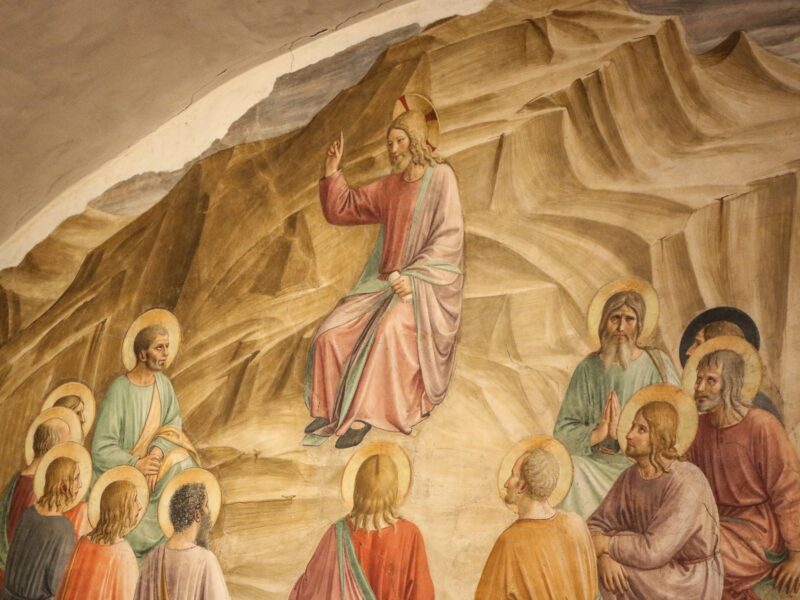
Being and Doing
The Feast of the Baptism of the Lord. Fr Richard Joseph Ounsworth considers how the baptism of Jesus points to his identity and his mission.
When a reading at Mass, especially the Gospel, has a reference like today’s, it always raises a question in the mind. To save you going to the end of the sermon, it is Luke 3:15-16,21-22. The question is obvious: what happens in verses 17 to 20?
There is no conspiracy. The Church is not trying to conceal the content of these verses, but only I suppose to spare Mass-goers from having to listen to more of the passage than might be directly relevant. The answer to our question is that, between the verses in which St John the Baptist points towards the coming Christ and those in which Jesus is in fact baptised, St Luke gives us what we might call a ‘flash-forward’. This is quite an unusual technique, being the opposite of the more common flashback: we are told that, in response to the preaching of John, Herod had him arrested, a fact told to us in slightly different ways also in Matthew and Mark.
But I think that St Luke is being very clever here, because he is, psychologically speaking, getting John off stage before the baptism of Jesus. Without denying that Christ was baptised by the Baptist, with this flash-forward, plus the use of the passive form (literally, ‘Jesus having been baptised’), Luke does precisely what John himself wanted to do, which is to point away from himself and towards Jesus.
This is appropriate today, the last day of Christmastide, a period in which we have especially been celebrating the identity of Jesus, the miraculous truth that he is the image of the invisible God, the Word-made-flesh. And in our reading we hear the response of the Father to the perfect prayer of his Son, a response of perfect love. It is to this that St Luke wishes to point us today: the identity if Christ as the beloved Son, a human being whose person is entirely constituted by the love which is what God is.
At the same time this baptism marks the beginning of Jesus’s ministry. Christ was not born simply to exist, to give us something to talk about, but to act. Specifically, as he himself says elsewhere, he came to serve, and to give his life as a ransom for many. So while in Christmastide it is vital that we confess the truth that Christ is God, we must also confess that he is God-with-us, and God for us.
How could he not be, when Jesus serving life and saving death are the playing out of his divine identity on the stage of human history? The rest of the Gospel is what a human life looks like when it is lived by someone whose existence is perfect love, a perfect response to the love of the Father.
As at the end of his life Christ found himself cast out with the despised and rejected of this world, so his working life among us was spent in that same solidarity, in the company of the outcast, the lowly and the despised. These are the outcasts who still find themselves in exile – figuratively – from the world, and so it is appropriate that Christ begins his ministry by passing through the Jordan, so re-enacting the return from exile and the entry into the Promised Land. In his humanity, Jesus emptied himself to take the form of a servant – in other words, to take the part of an exile so as to be able to lead us back home, to our heavenly home with the Father.
For us, this homeward journey also begins with a baptism, at which we received adoption as God’s children. This means that what the Father said to Jesus at his baptism, he now says to all of us: ‘I love you’. That word of love is now at the centre of our being: as for Jesus, our identity too is now God’s love for us, the perfect heart-breaking love of a Father for a Son. Today’s feast reminds us, then, of our vocation to live in accordance with this identity, to live lives of service in imitation of Christ, strengthened in the knowledge that, whatever joy and delight we have ever known in loving and being loved by anyone, God’s delight in us is infinitely greater.
Readings: Isaiah 40:1-5,9-11 | Titus 2:11-14,3:4-7 | Luke 3:15-16,21-22
Image: from a mosaic by Marko Rupnik SJ from the National Shrine of St John Paul II, Washington DC, photographed by Fr Lawrence Lew OP.



Pingback: Homilies for the Baptism of the Lord, Year C - SundayPrep
Tim O'Brien
Thank you and every Blessing for 2022. Tim. O’Brien
Pingback: Homilies for Second Sunday of Year C - SundayPrep